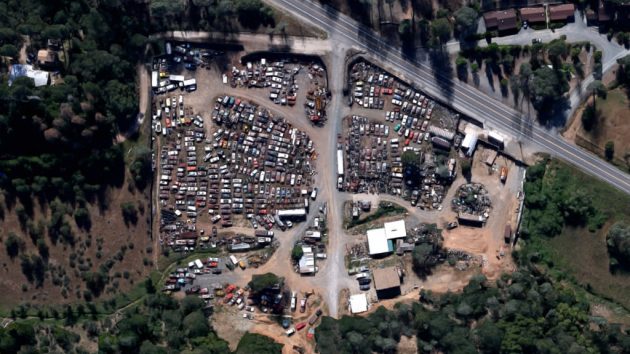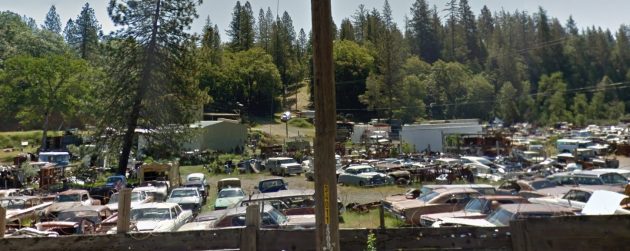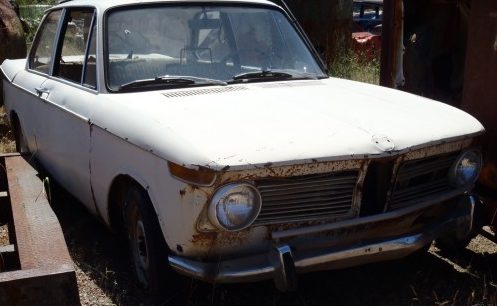Weimar Auto Wrecking out in Weimar, California has officially closed. They specialized in cars from 1947 to 1972. The yard is now for sale on craigslist. There are about 200 cars and they can be purchased separate from the land. They list 107 cars, as well as parts on their webpage and there’s lots of interesting stuff here!
A peek over the fence reveals lots of interesting cars. Most are in rusty condition, but there are definitely some gems here.
Some cars like this Anglia are mostly complete.
This BMW may be too rusty to save, but perhaps it would be good for parts.
This 1966 Barracuda looks mostly complete and nice from here. Perhaps it’s worth restoring as a driver. It’s hard to imagine anyone buying the yard and all the cars but perhaps a few can be saved from the crusher. Some have prices listed. For example, there is a 1956 Studebaker Night Hawk for $2200. Perhaps a few might live on as resto-mods.






I hope whoever shows interest in the land has an environmental impact study done first. Years of oil and gas dripping will be costly to mitigate.
Hi Bill, I’m sure they will. I sometimes think about the early 1900s when automobile development was at a crossroads: Electric cars vs gasoline cars. I know that progressive people champion the pollution free electric cars, but can you imagine 100 years of batteries in yards and dumps all over the country? :-( Terry J
I heard the term “coal fired cars” when talking about electric vehicles. Pretty funny, actually.
The technology to make electric cars with a range usable outside a city did not exist until very recently and even now is not really practical for very many people. How far would we have gotten on lead acid batteries with a range of 20 miles or less? The natural gas used to produce the electricity for my cars is a lot more efficient than gasoline and produces only a fraction of the pollution.
Greetings All,
David, far more coal fired plants.
Without more nuclear, the US doesn’t have the capability to charge the new ones if a transistion was to occur.
The technology still does not exist. There has been very little advancement in battery science. That is the holly grail of solutions for electric cars that have frustrated scientists since batteries were first made 2000 years ago. That is why hybrids are successful in our market and not electric cars.
Terry,
Current 12V lead-acid batteries are highly recycled, close to 99.7% if my memory is correct. The lithium-ion batteries in the current electric vehicles will have other uses (e.g. energy storage) once they are done as a vehicle battery.
Bill,
You’re right as far as electric vehicle is only as clean as the electricity that moves it. That said, a 100% coal grid is as clean as a 36 MPG car. Since most of the US’s grid is way cleaner than 100% coal, most electric vehicles are even cleaner. Let’s take a look at the top 10 best-selling vehicles in the US – F150, Silverado, Ram truck, CRV, Camry, Accord, etc. How many of them average 36 MPG or better in real-world driving? See the report earlier this year by the Union of
Concerned Scientists.
Finally, there is plenty of excess electricity generation, especially at night when many electric cars charge. The claim that the grid can’t handle electric cars simply isn’t true. The utilities are continuekaly upgrading the grid to meet future load, including electric cars.
??Night Hawk?? Familiar with Silver , Golden Hawk, Hawk GT…even the Packard Hawk. Not so much the Night Hawk.
Downvote…somebody is.
No worries…there seems to be a troll living their parent’s basement in their tighty whities and a wife beater t-shirt with mustard stains clicking the thumbs down icon. I’ve never heard of a Night Hawk either unless it is some sort of aftermarket/coach builder deal like the Stutz Black Hawk.
It’s in bad shape…..Take it out only at Night as to avoid embarrassment. :(
maybe the reference is to the ‘flight hawk’, introduced in ’56, i think.
He might mean Flight Hawk a 56 6cylinder car. 56 also had Power, Sky and Golden Hawk.
Flight Hawk
I can recall, through the late 70′ into the 90’s when there were quite a few service stations for sale for a number of years because they were an EPA nightmare to purchase. Excavating old underground tanks and having to mound the surrounding soil for a minimum of two years. Big money.
I was involved in that industry, it is much easier today. In the old days, contaminated soil had to be taken to a hazardous waste disposal site. Today, you pile it up on black tarps and treat it with microbes that eat the petroleum. The microbes are found in nature and concentrated for use in this industry. After a few months and some turning over, the soil tests clean and can be reused.
Actually I was required to fill two large underground tanks with sand for my location. End of subject.
i was working in California…….they would drill core samples near the tank and if they could detect any petroleum everything had to be dug up. The contaminated soil had to be trucked to the Dump site. Your soultion would have been better. I knew a widow that inherited her husbands car wash. It had stopped selling fuel a decade earlier…..the state came in and did there core drilling, off course found gas that had leaked. The bill for cleanup was something like 140,000…… For a small busisness worth maby 50K. She fought it but in the end, walked into the city council meeting with the deed to the property…when she gave them the deed so they could pay the bill, they stuttered real quick and gave her a 10 year waiver. By then the new processes had been developed and she could afford the cleanup. It was an ugly issue in crazy California for a few years.
@Bruce: had to look the Flight Hawk up. I had forgotten about that one and the Sky Hawk, too. A one-year wonder! Six cylinder and a column shift, usually.
I remember seeing a 70 or so model Camaro kitted out in similar “value line” togs, which faithfully took a little old lady to our neighborhood’s grocery store in the mid-eighties. An interesting juxtaposition of sporty styling and economy drivetrain.
I always made fun of my wife’s ’74 Camaro with 6-banger, auto tranny, AM radio and power steering, but it ran well, sipped gas and lasted for years. It was also bought for less money than the comparably-equipped Nova. No accounting for tastes, I guess.
I’m not sure if this is even an option.But I hope someone buys this Junk yard and keeps it going.Places like this are slowly but surely disappearing.Its really kinda sad. Im pretty sure most of the guys here on barn finds are like me. We love to spend our Saturday mornings just walking around places like this just lookin for whatever we’re lookin for.
CK, I am one that misses strolling through yards to find what I need or,a few times I would run across a yard I never knew about and stopped just to walk through and see what they had. Now days there are these yards -pull-a-part,pic_a-part ect. that you pay 1.00 and have at it. There prices used to be cheap,now they charge way to much. But at least you can get in and wander around.
Ya got it Bruce. The Flight Hawk was the bottom of the lie entry level Hawk with the flat head six, followed by the Power Hawk which offered v/8 and the Sky Hawk, which is the rarest to find of the 4 56 models and was a pillarless Hardtop offered with the Studebaker 289 and lastly the introduction of the Golden Hawk also a pillarless Hardtop with the 2 little fiberglass fins an the no good 352 overweight Packard v/8 used the one year. Springs were just too light to handle the massaive weight engine